We provide customers Multi Brand with Header Ecommerce used by big brands, bringing high aesthetics and logic. You can check this demo (pass: 4) to know how E-commerce header works.
The Header Ecommerce is a professional header and also requires more customization than other headers. However, you do not need to worry about this problem, we will guide you in detail so that you can create it.
In this guide, if you have 3 brand pages: WOMEN, MEN, and KIDS. The WOMEN brand is homepage by default. Let's stick to the steps to build it:
First, you add the section "Header Ecommerce" in "Header Group", and hide or remove another Header section.
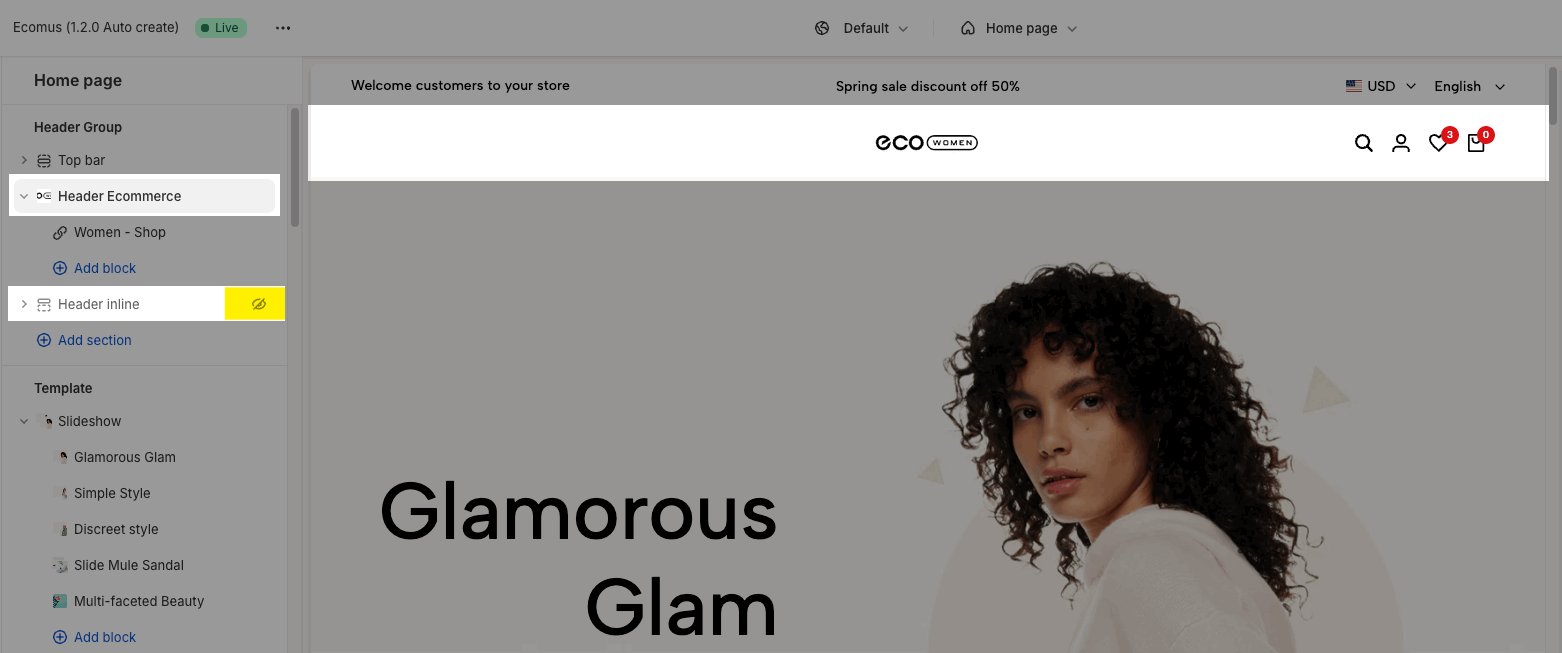
1. Create pages
Note: No need to create a page for WOMEN (default homepage).
1.1. Create Page template
For each Brand Menu you want to show on the Main Header, you create a template. Follow this video:
1.2. Create pages
Go to Online Store > Pages > create the new pages and assign them to the corresponding template:
1.3. Customize pages
Go to Theme customize > Pages > choose "Men", "Kids" pages to edit.
If you want to import "Men, Kids" template from Ecomus demo, you can follow this guide. You find "page.men.json" and "page.kids.json" to import.
2. Create Menu
2.1. Create menu
Important: In the "Header brands Ecomus" Navigation, a URL cannot be in two brands. For example, if you put the "Collection/All" page under both WOMEN and MEN brands, the WOMEN brand will be activated when you access "Collection/All
Go to Shopify admin > Content > Menu to create a navigation for the header menu.
Name: Header Ecommerce (or any name you want)
Required handle: theme_brands
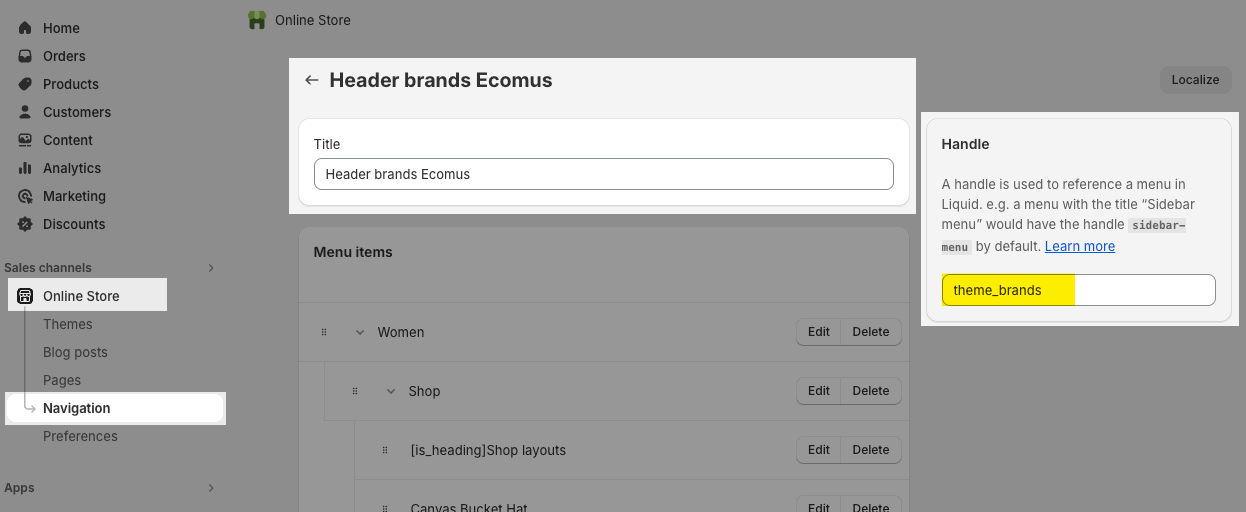
2.2. Add menu items
In Header Ecommerce, you need to follow the structure:
Level 1: Brand pages (Women, Men, Kids)
Level 2: Menus for each brand
Level 3: [is_heading] and Linklist items
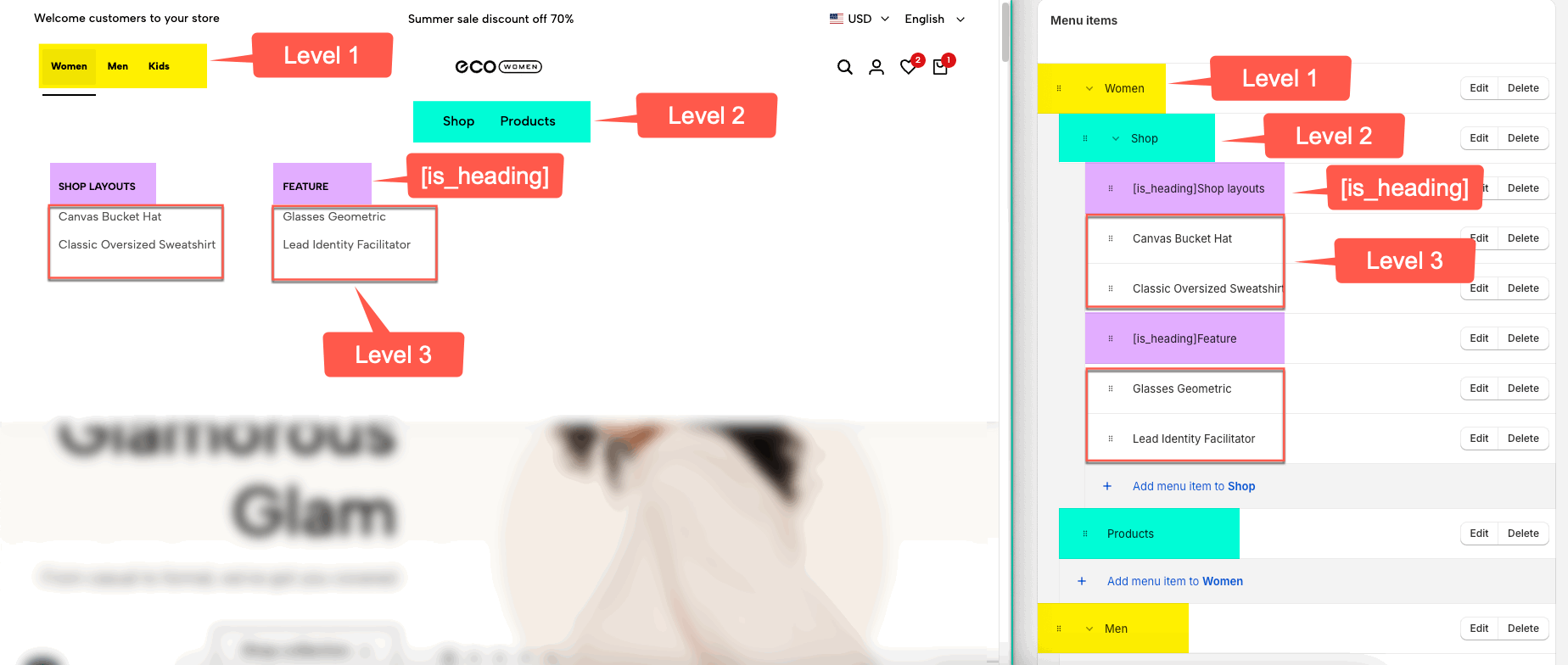
Next, you connect Level 1 items with the corresponding pages. Follow this video:
Similarly, you add the sub-menus (Level 2, Level 3) for Men and Kids. This is an example:
2.3. Level 2 menu
By default, Level 2 shows a link or dropdown (if the Level 2 has submenu - Level 3). Check this document to know more.
To show a megamenu for Level 2, you add "Mega menu block" and connect it with the key: "Level 1 - Level 2". There are 4 types of Mega menu blocks, you check this document.
Example: Women - Shop. Follow this video:
Result: Different menus on brand pages
3. Create MetaObject
3.1. Create MetaObject
Step 1: Go to Content > MetaObject > Add definition
Required name: Brand
Follow this video:
Step 2: Click 'Add fields' > choose the Type first. You will add at least 4 fields:
Name => Single line text
Url => Page
Logo => File
Logo mobile => File
Search => Product > List of products (You will create this field if you want search product suggestions to be different for each Brand Page)
Cart => Product > List of products (You will create this field if you want product suggestions in the cart to be different for each Brand Page)
Follow this video:
After creating all the fields you need, you will get a MetaObject with fields:

3.2. Add entries
Note: No need to create an entry for WOMEN (default homepage).
Go to Content > MetaObject > open "Brand" > Add entry. Please follow this video:
4. Reference elements for specific Brand Page
This step connects "page, logo, search, cart" you created in step 3 to the live page.
This feature will work as follows: if you add references to products, collections, page, blogs, or blog posts on a specific Brand Page, when you click on them, this component will remain on that page.
Reference elements included:
Pages => for Logo: different logo and mobile logo for each brand page.
Products => for search, cart suggest products.
Collections => when you click on these collections/ products in these collections, it will remain on the same brand page.
If you don't add a reference to it, it will default to the Brand Page Default (Home page).
You will connect for Product, Collection, Page, Blogs, or Blog posts similar the example below.
4.1. Reference for Pages
Step 1: Create Metafield (Pages)
Go to Settings > Custom data > Pages > Add definition
Name: Brand
Key: theme.brand
Content type: Metaobject
Reference: Brand
Please follow video below:
Step 2: Select Entry for Pages
Result: The logo, search suggestion, cart suggestion change when you select different brand pages. Please check this video:
4.2. Reference for Collections
Note: If your collections connect with Brand page; you can ignore products of collections. It assigns automically for products"
"The priority level is from inside out: if you have created a metafield and selected an Entry for the Brand page within a product, the product will receive the value of Products and not receive Collections. Similarly, it will prioritize Blog Posts first, then Blogs.
Step 1: Create Metafield (Collections)
Go to Settings > Custom data > Collections > Add definition
Name: Brand
Key: theme.brand
Content type: Metaobject
Reference: Brand
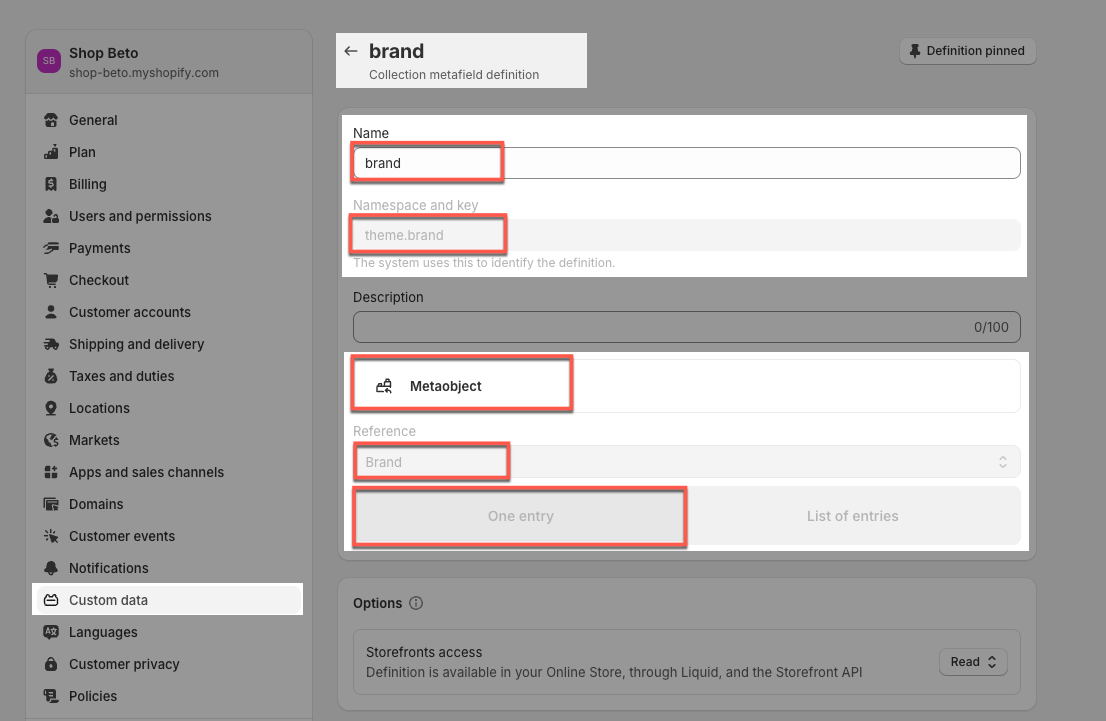
Step 2: Select Entry for Collections
You can follow this video to connect a collection to a brand page. Example, I connected "Men 3" to "MEN" brand => Video guide 1
Then all products in "Men 3" will connect to MEN brands too => Video guide 2
In the "Header brands Ecomus" Navigation, a URL collection cannot be in two brands. For example, if you put the "Men 3" collection under both WOMEN and MEN brands, the WOMEN brand will be activated when you access the "Men 3" collection.
Result: When you access the collection page, or products page of a reference collection, the corresponding brand page will be highlighted. Check "Video guide 2" above.
5. How to customize the Header Ecomerce (new)?
5.1. Config Header Ecomerce section
We prioritize the top first section header to show. Please delete header sections that you do not use.
Header by brand: If you choose header by brand, you can add multiple header sections, and each section will correspond to 1 brand.
Brand name: Enter the brand name (Example: Women)
Enter the brand name to be used in the mega menu. Leave blank to determine this is the default header section
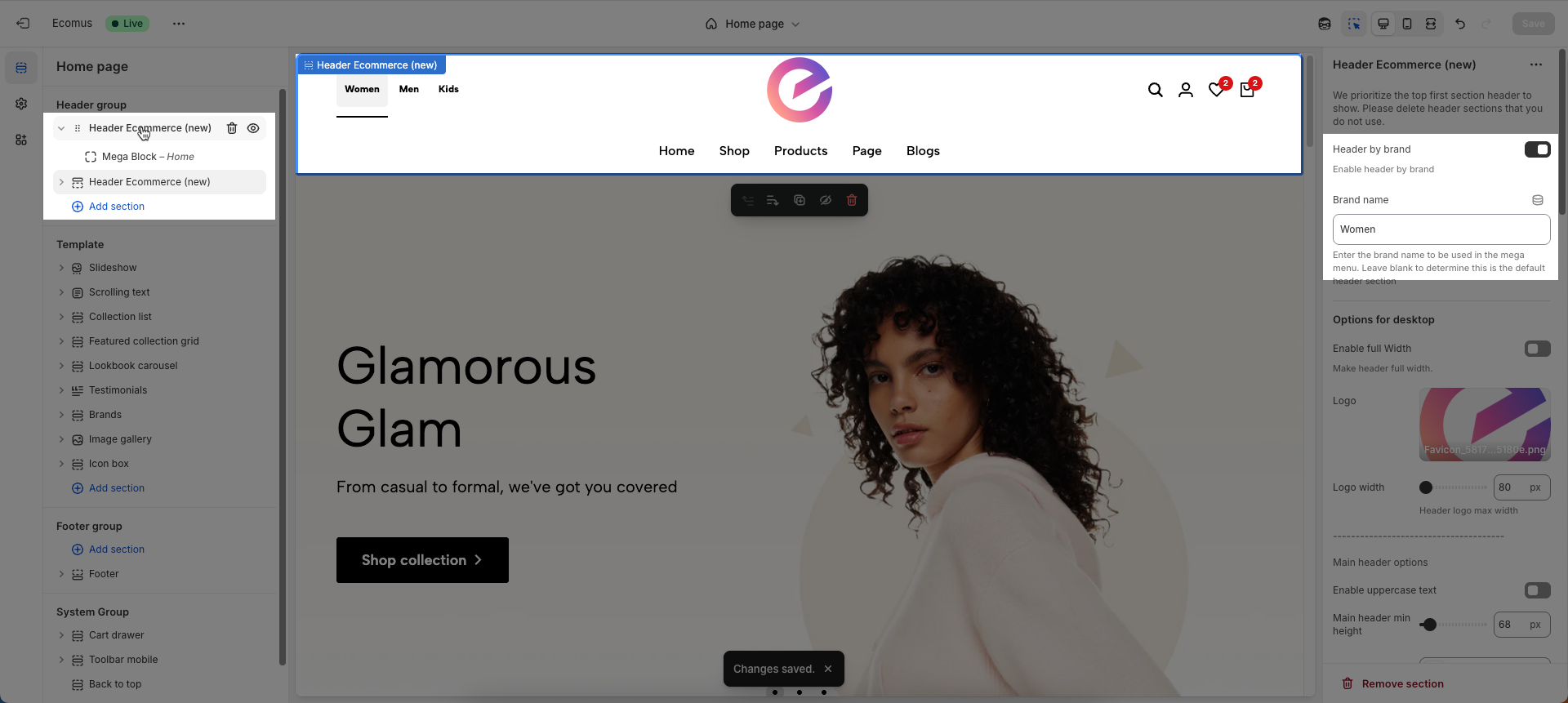
If enable Header by brand, to show megamenu for Level 2, add "Mega Menu Block" and you don't need to connect it to the key: "Level 1 - Level 2" but just connect to the level 2 key
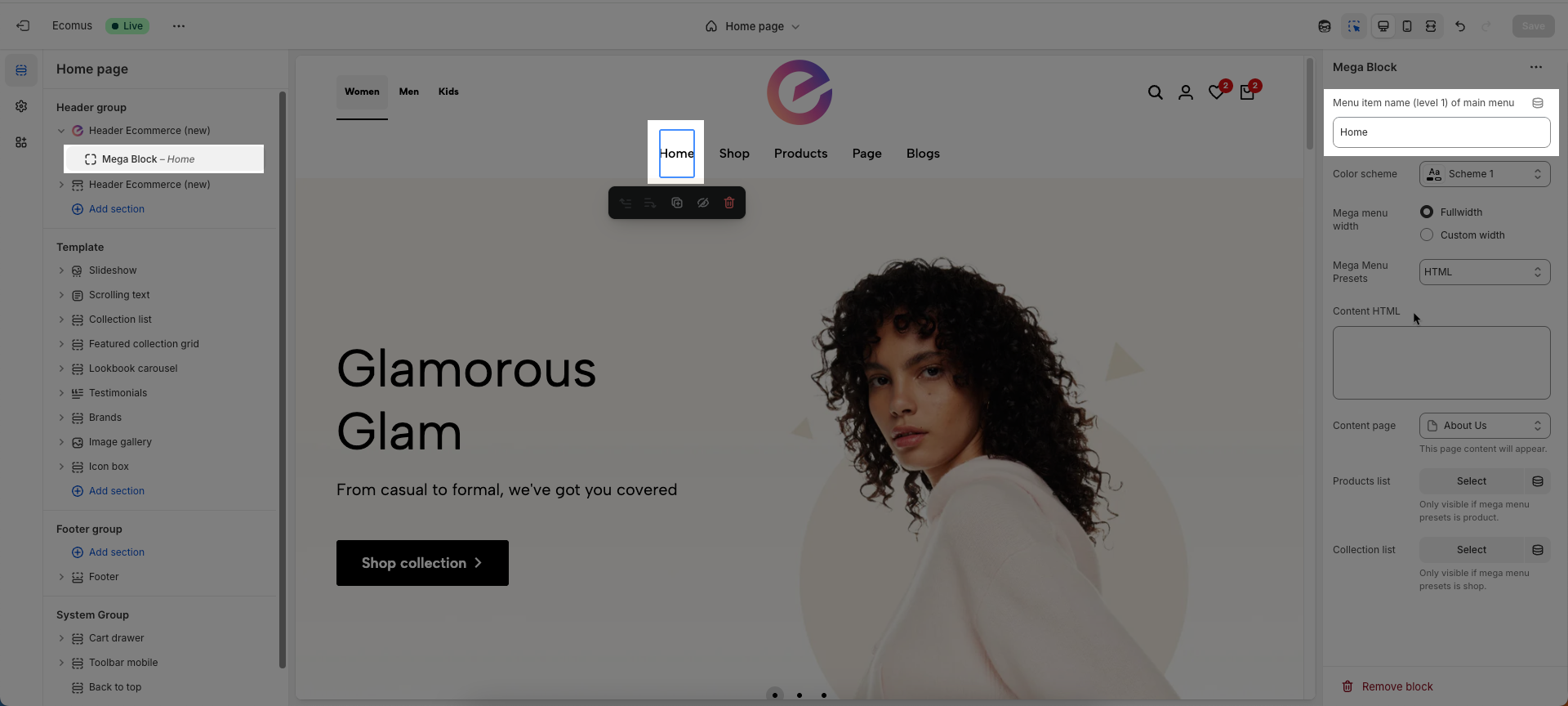
5.1.1. Options for desktop
Enable full Width: Check to enable full width for the header. When enabled, the header will stretch across the entire browser viewport
Logo: Upload your logo image file. This is the primary visual identifier for your brand, typically appearing at the top of the page.
Logo width: Set the width of the logo (in pixels) for desktop viewing. This width will automatically adjust for mobile devices to ensure optimal display.
Main header options
Enable uppercase text: Enable this option to transform all menu item text to uppercase.
Main header min height: Set the minimum height of the header on desktop. This affects the vertical space the header occupies on the page.
Colors schema: Select the color schema for the header. This schema will determine the header's background color and text color, ensuring color consistency across your website.
Group icons options. Only work on desktop
Show user: Check to display the customer account icon or link in the header. This link will direct to the login page or the customer's account page if they are already logged in.
Show compare: Check to display the compare icon in the header.
Turn on compare in theme settings first
Show wishlist: Check to display the wishlist icon in the header. This feature allows customers to save products for later viewing or purchase.
Turn on wishlist in theme settings first
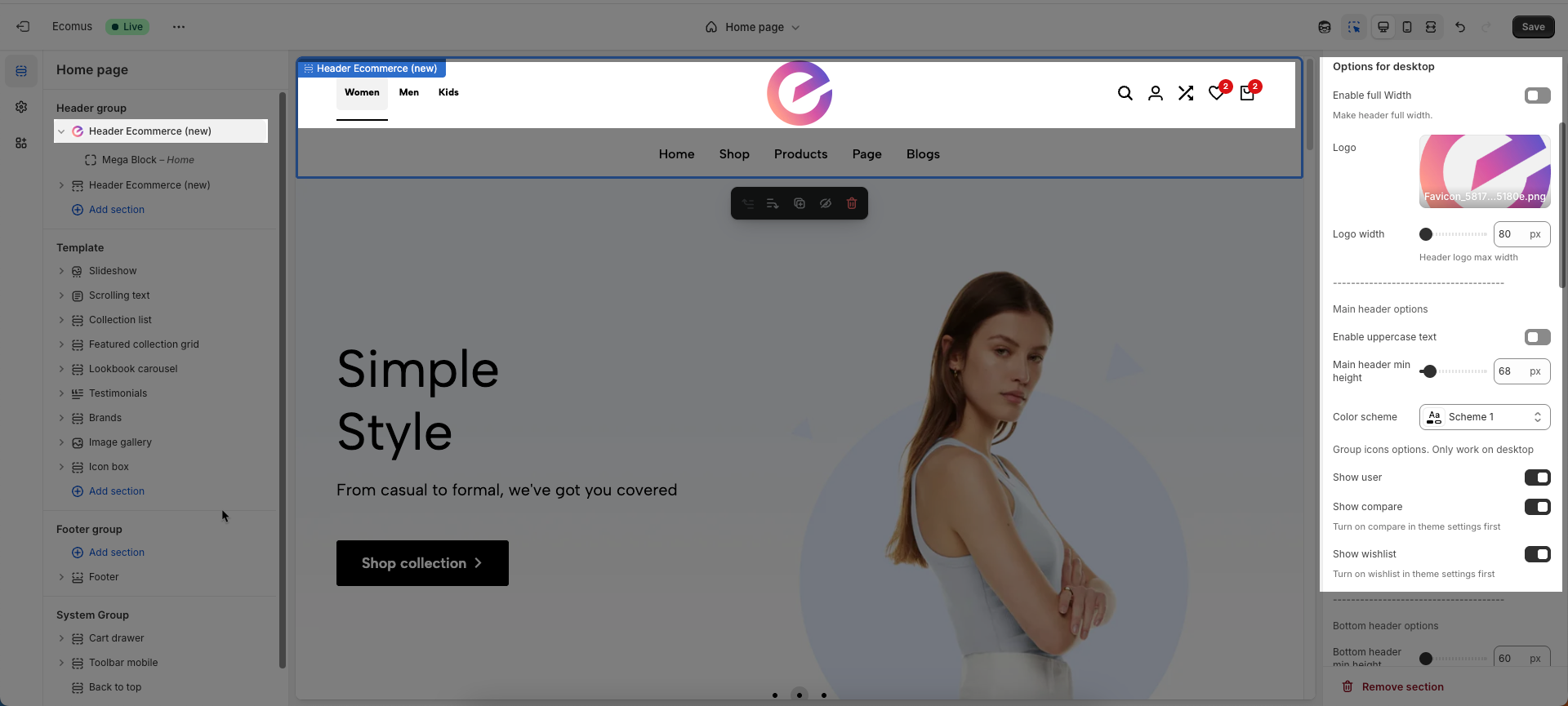
Bottom header options
Bottom header min height: Set the minimum height of the bottom header on desktop. This affects the vertical space the header occupies on the page.
Navigation options
Enable Lazy menu?: Enable this option to lazy load the menu. This improves initial page load speed by only loading parts of the menu when they are needed
Improve page load speed
Main menu position: Select the position of the main menu within the header. Common options include center-aligned, left-aligned, or right-aligned.
Menu item size: Set the font size for the main menu items.
Menu item weight: Set the font weight for the main menu items.
Enable uppercase text: Enable this option to transform all menu item text to uppercase.
Show dropdown arrow: Display a dropdown arrow icon next to main menu items that have submenus. This arrow will always be shown on submenu items.
Item main menu has submenu will show dropdown arrow. Always show in submenu item
Open dropdown items on event: Select the event to open dropdown menu items (on hover or click).
Click mode is forced on touch devices.
Spacing menu items: Set the horizontal spacing between main menu items.
Spacing between menu items
Open dropdown items on event: Select the event to open dropdown menu items (on hover or click).
Click mode is forced on touch devices.
Colors schema: Select the color schema for the bottom header. This schema will determine the header's background color and text color, ensuring color consistency across your website.
Bottom header border: you can choose None, Border top, Border bottom, Border top & bottom
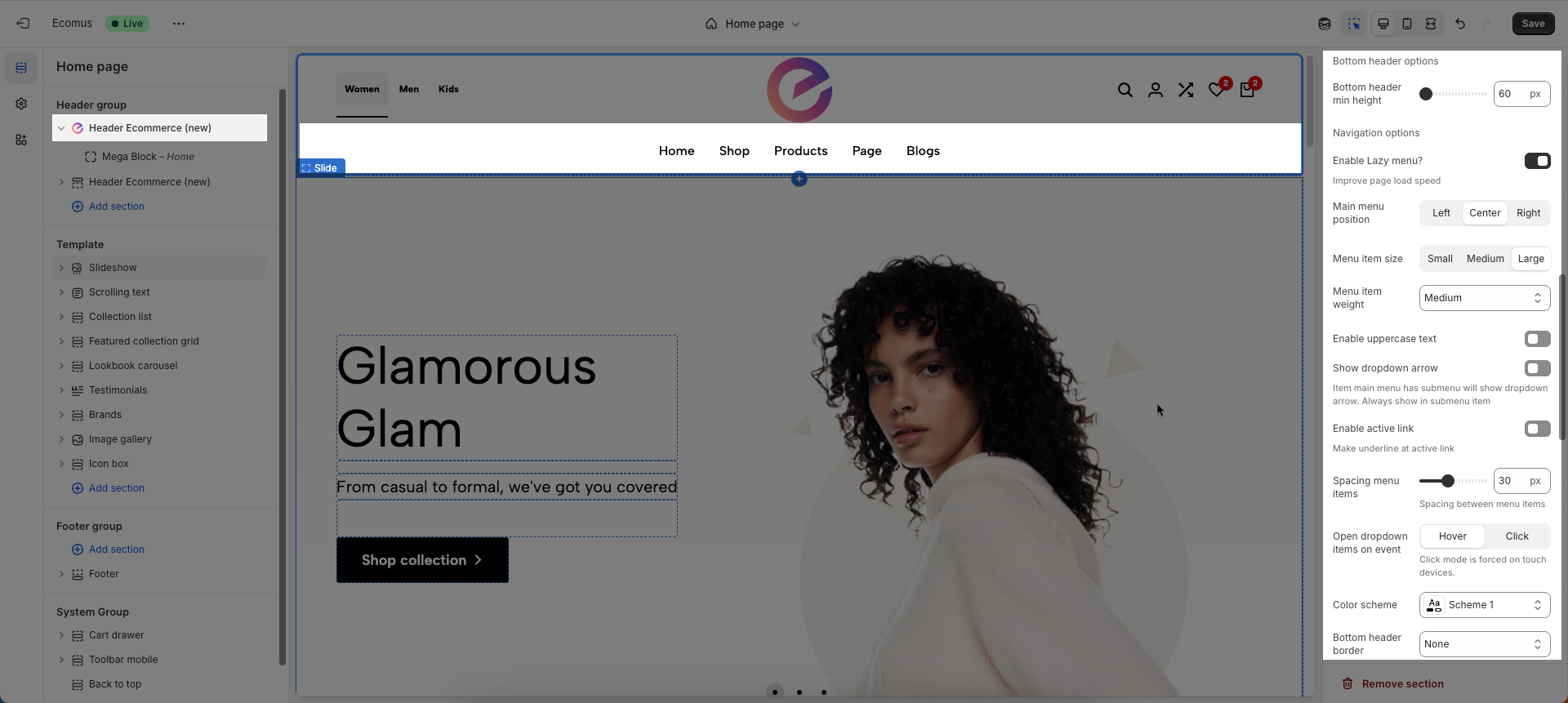
5.1.2. Options for mobile
Main header min height on mobile: Set the minimum height of the header on mobile devices. This ensures the header remains clearly visible and easy to interact with on smaller screens.
Logo mobile: Upload a separate logo image file specifically for mobile devices (optional). Use a logo optimized for smaller screens or a brand icon if desired.
Menu mobile: Select the navigation menu to be displayed when users access the website from a mobile device.
Enable header categories: Enable this option to display product categories directly in the header
Add menu categories: Select the list of collections or categories to be displayed when 'Enable header categories' is active.
Enable Lazy menu?: Enable this option to lazy load the menu on mobile devices. This improves initial page load speed by only loading parts of the menu when they are needed
Only click icon: When enabled, only clicking the arrow icon will expand a submenu; clicking the menu item text will navigate directly to the linked page.
Color menu mobile: Select the color schema for the mobile menu when it is open. This schema will determine its background color and text color, ensuring color consistency and readability.
Notice mobile: Enter a short notification text to be displayed at the top of the mobile menu
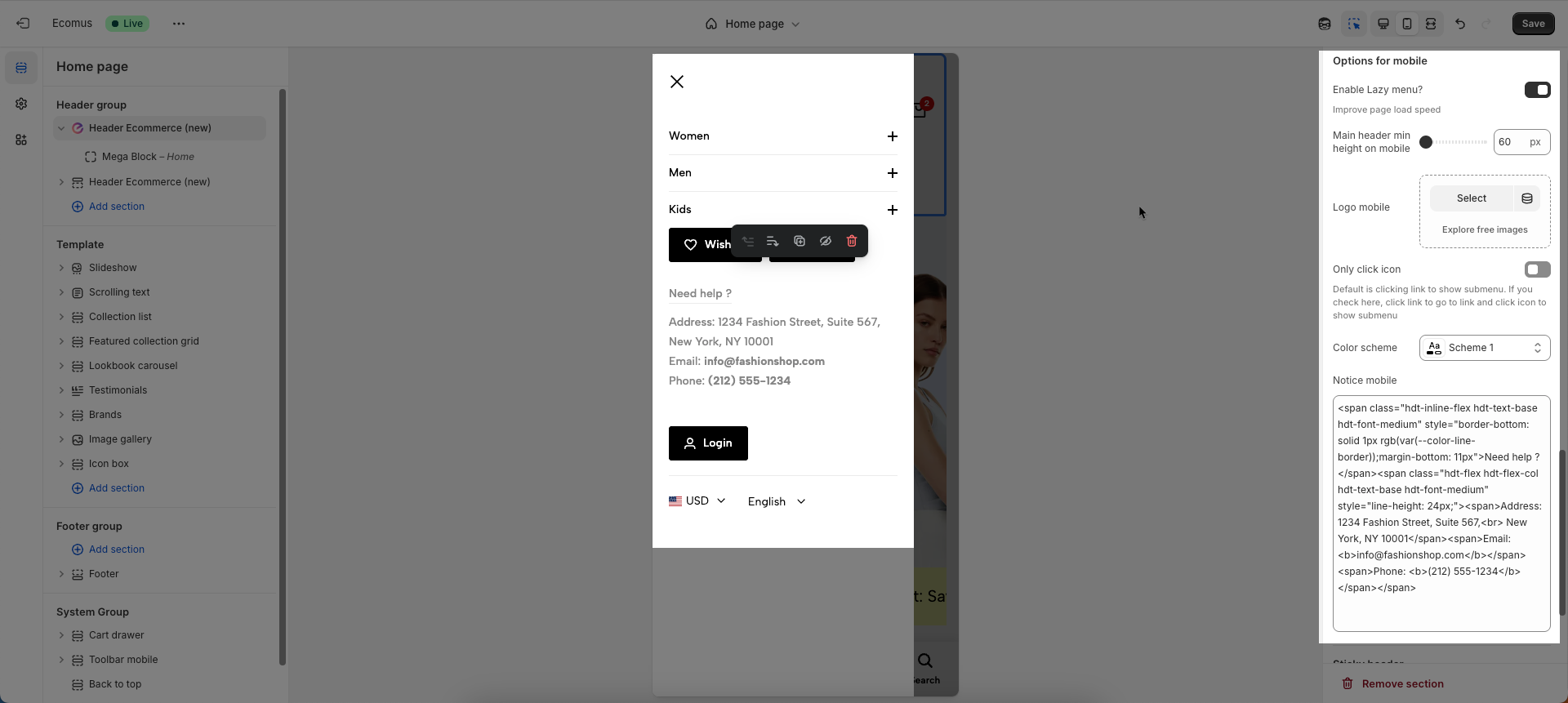
5.1.3. Sticky header
Enable header sticky: Select the behavior of the sticky header when scrolling.
On scroll up: The header reappears only when the user scrolls upwards.
Always: The header remains fixed at the top of the page after scrolling down a certain distance.
None: The header does not stick (it scrolls out of view).
5.2. Config Mega Block
Follow this Guide
5.3. Config Mega Block Column (10)
Follow this Guide
5.4. Config Mega Block Column (12)
Follow this Guide






